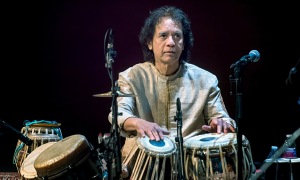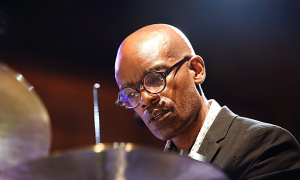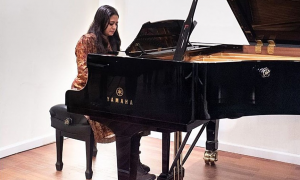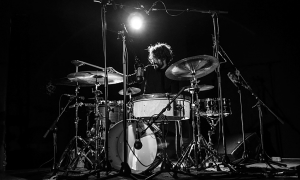Home » Jazz Articles » Under the Radar » Jazz Education: The Next Generation, Part 2
Jazz Education: The Next Generation, Part 2
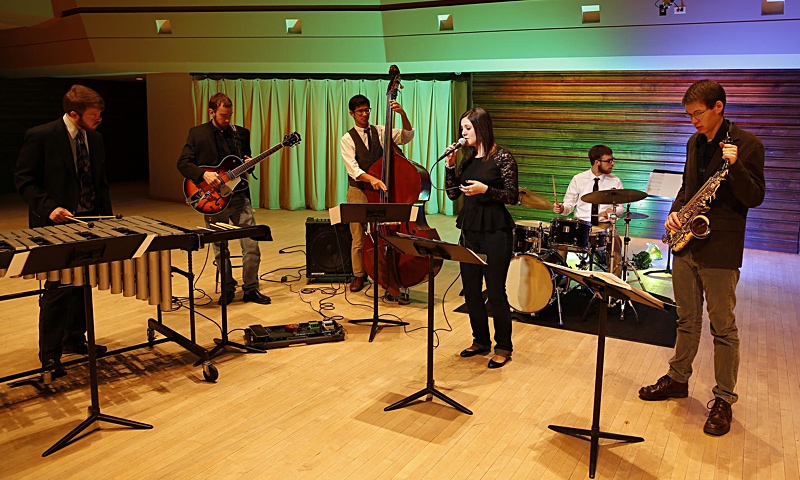
We let them know, as they go through our program that talent is only the first ingredient along the way to professional viability...
—Pete Malinverni, Head of Jazz Studies, SUNY Purchase
While jazz education has come a long way in the last forty years, there remains a curious otherworldly perception that, while breaching the stereotypes of the past, those typecasts have often been replaced with new hyperbole. Such was the case with the Academy Award winning movie Whiplash (Sony Classics, 2014). The picture's writer/director Damien Chazelle claims to have based the fictionalized account of a New York conservatory jazz program on his own, apparently nightmarish, experiences in a Princeton, New Jersey High School jazz program. The mass market success of Chazelle's picture should have been welcome exposure to the world of jazz education but its highly unrealistic, grossly sensationalized depiction of a sadistic, abusive environment makes for poor recruiting collateral.
So what remains lacking, in thinking about jazz education, seems to be a now long-established link to the professionalism that dominates the art. Antiquarians and casual players aside, the professional jazz class extends beyond leaders and session musicians. They are engineers, agents, promoters, producers, managers, authors and educators with a passion for their calling that is rarely surpassed in other careers. Yet the economics are more than challenging in a niche market, making a well-rounded, holistic education more of a necessity.
Practice, Pragmatism and Purchase
In the second part of this series, we focus will be on two schools that have made jazz education a cornerstone of their institutions. The State University of New York (SUNY) at Purchase and Toronto's Humber College; two institutions that are taking responsibility not just for music education but also for preparing students for managing their careers beyond the music.
Saxophonist Gerry Malkin recalls that when he arrived as a student at SUNY Purchase, his first classroom was in a double-wide trailer. A lot has changed. The university system in New York was established in 1948—one of the last states to do so—but the number of colleges and universities grew quickly over the next two decades. SUNY was ground-breaking in its progressive attitude. In 1953, SUNY took the unprecedented step of banning national fraternities and sororities that discriminated based on race or religion, from all of its campuses. The move was an impetus for similar actions from colleges across the country. Under former Governor Nelson A. Rockefeller, a further expansion took place in 1967 with the new Purchase campus representing "the cultural gem of the SUNY system," in his words. This early description has been borne out as the school has been ranked ninth in U.S. News & World Report's 2016 listing of top public liberal arts colleges, and a Princeton Review 2015 list of The Best 379 Colleges. Purchase's School of the Arts accounts for nearly half of all the school's students and administers the Conservatory of Music among its various Arts programs. Along with offering curriculums to conservatory students, Purchase allows Liberal Arts students to select many of the fine arts classes as well.
The impressive list of past and present faculty at Purchase is quite extensive and includes John Abercrombie, Vic Juris and Ingrid Jensen. Trumpeter Jon Faddis had played with Lionel Hampton and Charles Mingus developing a unique style that helped set him apart from early comparisons to Dizzy Gillespie. Baritone saxophonist Gary Smulyan played with Woody Herman in the late 1970s and went on to play in the big bands of Toshiko Akiyoshi/Lew Tabackin, Lionel Hampton, Freddie Hubbard, Tito Puente, and Clark Terry among many others. Tenor saxophonist Ralph Lalama, was a regular member of the Thad Jones and Mel Lewis led Village Vanguard Orchestra in the early 1980's. An earlier version of that band included his Purchase colleague, trombonist John Mosca who had also worked with Sarah Vaughan, Stan Getz and other top names. Drummer Kenny Washington had long been a favorite side man of legends such as Gillespie, Lee Konitz, Betty Carter, Clark Terry, and Tommy Flanagan, before becoming a legend himself. Drummer Richie Morales was a long-time member of Spyro Gyra and had recorded with the Brecker Brothers, Gato Barbieri, Al Di Meola and a host of other jazz and pop luminaries. Other Purchase faculty members include Bradley Brookshire, a harpsichordist and Grammy nominee, bassist Todd Coolman—a two-time Grammy winner—composer Laura Kaminsky, pianist Steven Lubin, bassist Tim Cobb who has recorded with Tony Bennett and Amy Winehouse.
Atop this talented collective sit Doug Munro, the founder of Jazz Studies Program at Purchase, and Pete Malinverni, the Coordinator and Head of Jazz Studies, who together represent the full spectrum of the school's program from inception to present day. Malinverni—who earned is his Master's degree through the Purchase Conservatory—is an impressively accomplished pianist and trio leader. While under-recognized as a recording artist, his Autumn in New York (Reservoir, 2002) garnered him critical praise both as a composer and musician. His Theme and Variations (Reservoir, 2006) was lauded for its masterful blend of classical and jazz influences in a solo setting. His affinity for a different amalgamation—sacred music and jazz—was successfully achieved with Joyful! (ArtistShare, 2007), a quintet outing that included Coolman (the previous Head of Jazz Studies) and Malinverni's vocalist wife Jody Sandhaus. Munro and Malinverni were well acquainted prior to their shared experience at Purchase as Munro mentored the pianist at an early age. Munro, a guitar virtuoso with credits on more than sixty recordings, has worked with an top-tier, cross-genre roster of artists including B.B.King, Eddie Gomez, Dr. Lonnie Smith, David "Fathead" Newman, Michael Urbaniak, Randy Brecker and Michael Brecker, Cornell Dupree, David Sanborn, Noel Redding, Todd Rundgren, Ron Wood, Toots Thielemans and Allen Toussaint. As a leader, he had received critical praise for his eclectic style on two of his Chase Music Group releases, The Blue Lady (1995) and Up Against It (2003). Munro is also a long-time staff member at Litchfield Jazz Camp, having been part of that faculty since 2009.
This past fall I interviewed Malinverni and Munro on a host of topics regarding jazz education at Purchase. Munro re-counts the beginnings of the program. "I started teaching at Purchase in 1989 as a part-time adjunct faculty in the Studio Composition Department. There was no Jazz Department then, only a few elective courses. In 1992 we got a new Dean of Music, Donald Steven. He asked me if I would be interested in developing an Undergrad and Graduate degree program in Jazz Studies for Purchase College. I spent the entire year, with the help of Dean Steven and my faculty mentor, James McElwaine, writing what would become our core curriculum. The program was officially launched in the spring semester, 1993. We started with 10 internal transfer students. The mission of the program was, and still is, to provide students, through teaching and mentoring, the skills and tools they would need to pursue a career as a professional musician. I directed the program for its first 10 years. I saw my role as being an advocate for our students, faculty and program. I was constantly trying to build the program towards, what I considered to be, our critical mass of 80 undergrads and 20 master's students. I was a tireless recruiter for our jazz program, trying to attract the best students and the best faculty to teach them. As the first Director I view my role as being one of builder. There have been three Directors of the Jazz Studies Program at Purchase. I was the first, bassist Todd Coolman, was the second Director. Todd took over the Directorship in 2003. I view Todd as being the force that made our Jazz Program great. Under Todd Coolman's direction and tireless work our program reached its current international status as a top Jazz Studies Program. In 2013 Pete Malinverni took over as our third Director. Todd and I were both overjoyed that Pete accepted the position. Pete had been teaching in the program for many years. We both felt that he had the vision and energy to take the Jazz Studies Program and put his own personal stamp on it. We are already seeing evidence of Pete's vision for what a Jazz Studies Program should be providing for its students in the current times. Pete has revamped and brought back our jazz vocal major. He also works across the campus bringing students from other programs into the jazz experience while taking our jazz students and giving them opportunities outside the traditional jazz curriculum. I am excited to see what the future holds for our program under Pete's impressive leadership."
Malinverni adds a pragmatic approach to the overall mission of the program. "I believe the most important thing we can do for our students is to provide as "real-world" an experience as possible in the classroom. The way I and many of my colleagues came up was by learning under the pressure of playing with unquestioned -and demanding! -masters. That paradigm is no longer as available to young musicians, as the touring band is less common these days. So, when a task is assigned in a class or rehearsal, we expect excellence and professional comportment. My specific role is that of guiding our program toward a model including that type of rigor but tempered with love—so the students know that, for now, with us, their mistakes will be corrected and their next attempts will be heard with fresh ears—a luxury not often found on the outside, where you make it happen now -or never."
What are the elements that make the Purchase program stand out from other schools? Munro offers the following assessment. "I think there are three unique features about our Jazz Studies Program at Purchase. The first is the sense of community among the students. We are located 25 miles north of NYC in a very secluded part of Westchester County. There is no college town to hang out in. The students have created their own community of musicians. I have seen this happen continuously since the first year of the program. Our students help each other, they watch out for each other, they hang out together in both playing and social situations. There is no prejudice regarding race, gender, weight, coolness etc. It's pretty unique. The second aspect is the jazz faculty. Todd Coolman insisted that if you taught private lessons you had to come to the college to teach the students. The students would not be allowed to go the teacher's pad to take a lesson. This move really helped to build a sense of community within the faculty. They would all see each other at the college. It was a gas for the students too because they would see all these big name jazz artists in the hall of the music building. This practice is becoming more common now but when Todd started it, it was not the common practice for the NYC area programs. The third feature is that all of our classes are taught by professional jazz musicians. Every class, including jazz history (which is taught by Kenny Washington!) is taught by cats that are out in the professional arena. We don't have grad assistants teaching the basic courses or combos. It's pretty unique." Malinverni adds a note about the importance of mutual respect within the overall community. "At our place, we view our students as prospective colleagues so we tell them the truth in a way that leaves no room for ambiguity but is delivered respectfully, as positive criticism, helping our students along the way toward the artists they're becoming."
Admission to the Purchase program is competitive. Munro talks about the prerequisite conditions for entry. "We are looking for students who already are listening and playing jazz. Most students start to listen and play jazz in their High School years. We realize that their level and depth of understanding may not be that high yet. We don't expect full blown consummate players but we do expect to hear some jazz vocabulary, evidence of accumulation of repertoire and a level of technical ability that allows them to speak the language on their instrument."
Munro believes that Purchase offers the best facilities for students in the New York City area. With more than sixty practice rooms, almost one-hundred Steinway grand pianos and recording studios, under the direction of Grammy winning engineer Peter Denenberg, students are provided with a state of the art setting for developing and building their skills. The school's Performing Arts Center includes four performance areas and has played host to the likes of Sonny Rollins, Pat Metheny and many others. Purchase has two large ensembles, The Purchase Jazz Orchestra under Coolman and Faddis' direction and The Purchase Latin Jazz Orchestra led by David DeJesus. The ensembles have the opportunity to perform annually at prominent New York clubs such as Dizzy's Club Coca Cola, Birdland and the Blues Note. Student performers also have what Malinverni describes as a "home away from home" in Greenwich Village at Smalls Jazz Club. The pianist Spike Wilner is a club owner and Purchase Graduate School alum. "I and most of my colleagues often call students to perform with us, as members of our groups or to sit in on our engagements in NYC. Also, since all classes and rehearsals take place on campus, impromptu playing sessions and conversations about the music are a commonplace among us." says Malinverni. I had asked about the process used to determine the type of ensemble in which students collaborate. Malinverni describes that procedure. "I put together each of our fifteen Combos with an eye toward well-matched groups of musicians working under the wings of professors who will offer a positive environment in which to thrive." Munro adds additional detail. "We start with the number of small combos we have, say for example 16, when then make sure we can populate each combo with 1 drummer, 1 bassist, 1 guitarist and 1 pianist. From there we can add vocalists and horn players as needed. All of our combos are "theme based." For example, I teach combos that play the music from Charles Mingus' "Ah Um," or Chick Corea's "Light As a Feather" and a Horace Silver themed combo. The instrumentation for the combos is often dictated by what your combos theme is for that semester. Populating the combos is not an exact science but we do our best to insure a great combo experience for all of our students."
Purchase College is a somewhat unique setting in that an overall dedication to the arts is a cornerstone of the school. Malinverni and Munro explain how that overall environment impacts the jazz program. Malinverni states, "It makes a big difference -I don't think the arts in general and Jazz in particular are treated with as high a degree of respect in other institutions as they are at Purchase. I and several of my colleagues know the college president, provost and other upper administration folks personally and they are present at our performances -on and off campus -more often than they are not. I do not take this support for granted. When former Governor Nelson Rockefeller founded the State University system he inaugurated the Purchase campus as a hub for the arts in the state. On our campus, we have four separate Conservatories -of Music, Dance, Visual Arts and Drama -and our students take advantage of collaboration across those entities." Munro adds, "Collaboration between the conservatories is very common. It's a great way for students to foster the contacts they will need to succeed in the real world. Lately the college has started going one step further by integrating the Liberal Arts side of the campus with the conservatory programs. We have a new major called Arts Management that is showing great promise. We also have conservatory class offerings for non-majors. Our college is dedicated to a "one college" community as opposed to the "siloing" of programs."
I asked how the Purchase Jazz Studies Program helping students to better prepare for their own future security. Malinverni states, "We make sure that our students learn professional comportment, beginning right away in their freshman years. They are taught that punctuality and thoughtful presentation are essential to staying busy in a competitive environment. Many of our students avail themselves of classes from the Arts and Entrepreneurship courses offered at the college and we are currently working on expanding that curriculum. I think young musicians are always optimistic about the future and very seldom have a specific idea of what will await them upon graduation. And I think that's a good thing. We let them know, as they go through our program that talent is only the first ingredient along the way to professional viability and that, ultimately, their hard work and perseverance will be the determining factors in their musical lives."
Same Time; Different Country: Humber College
Less than an eight-hour drive north of the border, Toronto's Humber College resides in three clusters of campuses. The school—coincidentally—was founded in 1967, the same year as SUNY Purchase. With about twenty-thousand full-time and more than fifty-thousand part-time students, Humber specializes in technology fields, business, liberal arts and the arts. Denny Christianson is the Director of the Music Program at Humber School of Creative and Performing Arts which offers degrees or certificates in Jazz and Commercial Music, Jazz Performance, Music Business, and Music Composition.
As Christianson tells it, "by 1976 [Humber] was drawing top-notch students, as it was the only place in Canada where you could study jazz, and all the top working musicians were on faculty." Still, it wasn't until 2005, following approval from the Minister of Education, that the school began to offer a four-year Bachelor degree.
Christianson describes his role as one of keeping the program focused on the school's mission. "My job is to see that we stay focused on what our mission is, which is to give our students the best possible foundation for a successful career in music, and provide as many paths to that goal as possible. With that in mind, we created a cutting edge degree, with mandatory courses in midi technology, recording and producing master classes, music business, and creative development, which trains them for their 3rd year final recital, and their 4th year recording project in our state of the art recording studio. The results of all of this practical and hands-on experiences is that our students walk out the door with not only a BMus, but they have the mindset and business smarts of a top flight young pro....and tons of them have gone on to postgrad studies at places like Julliard, Berklee, University of Toronto, McGill, etc."
The faculty (seventeen full-time; seventy-five part-time) boasts of ten Juno winners (a Canadian equivalent of the Grammies) and a measure of the program's success is that twenty Humber alum were themselves nominated for the Juno in 2016 and seven won. Producers in Residence have included Tommy LiPuma, Al Schmidt, Greg Wells and Ken Scott while the Artists in Residence program has brought in Michael Brecker, Dave Holland, Vince Mendoza, Joe Lovano, John Scofield, Jack DeJohnette, Steve Gadd and others. The school features eight classrooms fully equipped for teaching, which become rehearsal space for Humber's fifty-two student ensembles. There is a midi classroom, an electronic classroom for teaching the recording process, the state-of-the-art studio and a five-hundred and fifty seat auditorium utilized as a performing classroom and concert hall.
I asked Christianson if the jazz program at Humber has an academically historical component to examine the roots of the music in the framework of its role in the development of modern jazz. He explained that Humber has ..."a three semester contemporary Music History course which traces all forms of North American music from early 1800 s (full development of New Orleans) and post-Civil War music, into music halls, Broadway, etc., with an earlier path of Delta Blues, into proliferation of R&B, into modern pop music with a parallel path of jazz history. We also offer several World Jazz groups, West African project, led by Waleed Abdulhamid, world hand drumming with Steve Mancuso, Indo jazz from Tabla master Ravi Naimpally, Latin jazz by Hilario Duran, and Brazilian jazz from Gord Sheard."
The Humber program is quite competitive but the program provides an alternative for students who need more preparation. Some students who are not ready for the degree program can qualify for Humber's Foundations course, giving them a year to hone their skills and re-apply. Up to eighty-percent of those students are accepted into the degree program the following year. Once students have been auditioned and sorted into one or more of the fifty-two Humber ensembles they have the unique opportunity to play Monday night sessions at Toronto's Rex Hotel Jazz & Blues Bar. The ensembles are also shuttled out to perform at local schools as part of the "Jazz in the Schools" program that has given eighty-thousand students the opportunity to hear live jazz.
Christianson has focused expectations of how the Humber program can help in shaping the future of jazz. "I feel what we are doing is hugely important, because no one can make it very easily as a player by themselves. The old circuits of jazz venues are gone now, so the new generation have to be business-wise. We are one of the few schools who not only offer a solid foundation as a jazz performer, but also give them a business foundation, and a recording/producing foundation...they will need all of that, plus self-discipline and self-promotion. Mainly through the music business courses I have pointed to, and by consistently mentoring them on their own self-worth...we are seeing a return to demanding the respect of being properly paid.
Thanks to Doug Munro, Pete Malinverni, Denny Christianson, Waleed Abdulhamid and David White for their time, their participation in the interviews and/or pointing me in the right direction.
SUNY Purchase Artists
David White Jazz Orchestra: Flashpoint
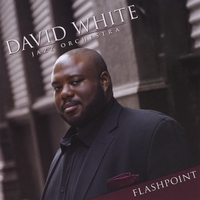 With a faculty that includes John Abercrombie, Eric Alexander, Scott Colley, Jon Faddis, Jon Gordon and Kenny Washington -Vocals, the Purchase College Jazz Studies Program is a leading talent pool for artists. No one alumnus epitomizes that capacity better than trombonist, composer and arranger David White on his debut, Flashpoint. Though he's still relatively unknown outside the New York circuit, White has played with the likes of Slide Hampton, Delfeayo Marsalis and Kenny Burrell. White's Jazz Orchestra deftly combines the traditions of big band music with open improvisation and inventive arrangements, with eight of his seventeen-piece orchestra's members taking memorable solos throughout the collection.
With a faculty that includes John Abercrombie, Eric Alexander, Scott Colley, Jon Faddis, Jon Gordon and Kenny Washington -Vocals, the Purchase College Jazz Studies Program is a leading talent pool for artists. No one alumnus epitomizes that capacity better than trombonist, composer and arranger David White on his debut, Flashpoint. Though he's still relatively unknown outside the New York circuit, White has played with the likes of Slide Hampton, Delfeayo Marsalis and Kenny Burrell. White's Jazz Orchestra deftly combines the traditions of big band music with open improvisation and inventive arrangements, with eight of his seventeen-piece orchestra's members taking memorable solos throughout the collection. Duke Ellington's up-tempo "David Danced Before the Lord with All His Might" opens the set with a retrospective treatment in its more homogenous big band style. The tribute may be a bit of misdirection, as White's own compositions and arrangements follow a distinctly modern approach. However, the two musicians share an understanding of composition and writing for large ensembles. The slow tempo "Eyes Closed" highlights White's ability to reference but not duplicate traditional intonations. The piece includes brilliant solos from pianist Nick Consol and saxophonist Sam Dillon, while the orchestra provides a restrained backdrop. The overall effect is that of realizing satisfying sense of completion. Similarly, "First Light" is solidly built around solos from tenor saxophonist Sam Taylor and White, before the orchestra builds out to a moderate but dramatic tempo.
The potential of the full orchestra is on display in equal measure to the solo sections. The rhythmic drive is appropriately bluesy on "Love in a Blue Time," which features solos from White, Consol and alto saxophonist Andrew Gould. "Secrets" holds some personal significance to White, and the orchestra plays with a sensitivity that reflects the composer's inspiration. "I Have a Bad Feeling About This," with Volker Goetze's flugelhorn solo, "I'll See You in Court," and "Mister Shepherd's Blues"—where trombonist Melissa Gardiner, trumpeter Miki Hirose and Dillon share quality solo time—are more in line with full out swing.
With the exception of the Ellington opener, White composed and arranged all the material on Flashpoint, taking full advantage of instrumental shading by varying the content and using great imagination in executing his vision. White clearly knows his jazz history and strikes a perfect balance, by incorporating his musical influences while defining his own progressive style. The musicians are polished and first rate, playing with nuance or great passion where appropriate. Flashpoint would be an outstanding recording in any composer's portfolio, but is all the more impressive as a first outing, with White leaving much to look forward to. Track Listing: David Danced Before the Lord With All His Might; Eyes Closed; Love in a Blue Time; First Light; Secrets;I Have a Bad Feeling About This; Pandora; I'll See You in Court; First Lullaby; Mister Shepherd's Blues. Personnel: David White: composer, arranger, conductor, trombone; Andrew Gould: alto saxophone; Omar Daniels: alto saxophone; Sam Taylor: tenor saxophone; Sam Dillon: tenor saxophone; Stephen Plekan: baritone saxophone; Miki Hirose: trumpet; Volker Goetze: trumpet, flugelhorn; Alicia Rau: trumpet; Michael Irwin: trumpet, flugelhorn; Melissa Gardiner: trombone; Rick Parker: trombone; Barry Cooper: trombone; Robert Statel: bass trombone; Nick Consol: piano; Doug Drewes: bass; Paul Francis: drums.
David White Jazz Orchestra: The Chase
 Some of the same high school kids that were jamming with composer/arranger/trombonist David White more than fifteen years ago still occupy a space alongside newer faces in his New York-based jazz orchestra. Tradition and transition are very much at the core of White's approach to progressive swing. White continues to express his unique style of progressive swing on his sophomore release The Chase. Like his debut Flashpoint (Self-Produced, 2007), The Chase pushes instrumental boundaries while paying just enough respect to convention.
Some of the same high school kids that were jamming with composer/arranger/trombonist David White more than fifteen years ago still occupy a space alongside newer faces in his New York-based jazz orchestra. Tradition and transition are very much at the core of White's approach to progressive swing. White continues to express his unique style of progressive swing on his sophomore release The Chase. Like his debut Flashpoint (Self-Produced, 2007), The Chase pushes instrumental boundaries while paying just enough respect to convention. White's democratic process allows his band mates plenty of spotlight time. The traditional swing opening of "Mister Shepherd's Misadventures" is quickly possessed by blistering solos from saxophonist Sam Dillon and trumpeter Miki Hirose. "And The People Could Fly" incorporates a bluesy element and standout work from pianist Nick Consol and trumpeter Pablo Masis. "The Sweetest Bite of Cherry" slows the pace down initially while saxophonist Sam Taylor and drummer Ryan Cavanaugh create a palpable tension, agitating for greater acceleration.
White himself takes a rare turn at soloing on the cinematic "Persistence," serving a reminder that his skills include being a fine player. White is one among five trombonists in the ensemble and another, David Reitz, gets to show his chops on "The Shakedown." Alto player Andrew Gould offers prominent performances on both of the aforementioned pieces. Yet another trombonist, Rick Parker, and alto saxophonist Omar Daniels get their chance to shine on the mid-tempo closer "Blues for Sally Draper."
While White deliberately places the solos in these tightly arranged pieces, they unfold spontaneously and have an organic improvisational feel. This seamless integration of swing and improvisation give White's original compositions a captivating quality. The rejuvenated condition and status of big band music has been intimately tied to a handful of modern-day composers among which White is prominent. He is a musical activist encouraging risk without tormenting the music to accomplish the task. White continues to grow as a ground-breaking composer and a forceful orchestrator. Track Listing: Mister Shepherd's Misadventures; And the People Can Fly; The Sweetest Bite of Cherry; Persistence; The Shakedown; Blues for Sally Draper. Personnel: David White: music director, composer, trombone; Andrew Gould: alto saxophone; Omar Daniels: alto saxophone; Sam Taylor: tenor saxophone; Sam Dillon: tenor saxophone; Tim Stocker: baritone saxophone; Miki Hirose: trumpet; Colin Brigstocke: trumpet; Alicia Rau: trumpet; Pablo Masis: trumpet; Rick Parker: trombone; Dan Reitz: trombone; Aliana Alster: trombone; Rob Stattel: bass trombone; Nick Consol: piano; Phil Rowan: bass; Ryan Cavan: drums.
Humber Artists
Humber Studio Jazz Ensemble: Another Parallel Reality
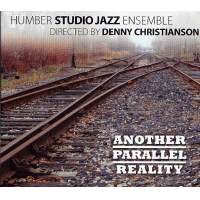 The pundits who regularly question the vital signs of jazz would be well served to turn their ears toward the Humber Studio Jazz Ensemble. Almost two-dozen albums into a constantly evolving presence, Denny Christianson, the Director of Toronto's Humber Music Program, has been mentoring young musicians through their persistent reinventing of sound and process. The combined passion for the music and an expert knowledge of the form have created an experience that is keeping modern big band music alive, healthy and growing. The twenty-one piece ensemble features some of Humber's School of Creative and Performing Arts most distinctive young jazz players on Another Parallel Reality.
The pundits who regularly question the vital signs of jazz would be well served to turn their ears toward the Humber Studio Jazz Ensemble. Almost two-dozen albums into a constantly evolving presence, Denny Christianson, the Director of Toronto's Humber Music Program, has been mentoring young musicians through their persistent reinventing of sound and process. The combined passion for the music and an expert knowledge of the form have created an experience that is keeping modern big band music alive, healthy and growing. The twenty-one piece ensemble features some of Humber's School of Creative and Performing Arts most distinctive young jazz players on Another Parallel Reality. Each year the Humber Music Program recruits a marquee jazz artist for a brief residency during which the artist, faculty and students work on the selection of pieces, writing of charts, and rehearsals, all culminating in a live concert. In the case of Another Parallel Reality the title is a very slight spin on a collection from this event's resident, drummer Jack DeJohnette. He joins the ranks of pianist Danilo Perez, bassist Dave Holland, saxophonists Michael Brecker and Chris Potter and trumpeter Dave Douglas who, among others, have participated in the Humber program.
Of the ten pieces on Another Parallel Reality, DeJohnette penned six and co-wrote another with guitar icon Pat Metheny. The arrangements are implemented by various members of the Humber faculty. "Jack In" is the imposing opener which features fine solos from pianist James Hill, Christian Brown on tenor sax, and trombonist Brad Gilchtist. The more avant-garde "New Muse" has a snake-like quality to its movement with added tension in the quietly menacing sounds of Chris Rennie's tenor sax and Josh Hung's trumpet. "Indigo Dreamscapes" appropriately floats on the ethereal wordless vocals of Lydia Persaud and Chynna Lewis before it eventually drifts into a slightly off-kilter conclusion. These same two vocalists shine on the Duke Ellington classic "Do Nothin' Til You Hear From Me." Persaud and Lewis' stellar performance of the difficult scat technique is so satisfying that it would have made Ella Fitzgerald take notice. Latin rhythms take over on "Nine Over Reggae," the DeJohnette/Metheny composition from Parallel Realities (MCA Records, 2004). Guitarist Sam Dickenson supplies a fine solo that is a bit more rock oriented than the Metheny original.
The atmospheric rhythms on Another Parallel Reality, may be set in the big band era but the ensemble plays to the present, opening up harmonies and improvisations. Where more conventional scoring is utilized, it presents a perfect showcase for the eye-opening performances of Persaud and Lewis. On Another Parallel Reality Christianson is careful in not possessing the sense of space common to so much contemporary big band music. The Humber arrangements place just the right amount of examination on each of the pieces so that style and technique are not being over analyzed to the detriment of the performances. Another Parallel Reality is an impressive album and Christianson has fused the many individual talents of the Humber Studio Jazz Ensemble into a tight and precise unit who happen to be a lot of fun to listen to. Track Listing: Jack In; New Muse; Indigo Dreamscapes; Do Nothin' Til You Hear From Me; Nine Over Reggae; Exotic Isles; You Can Have It; Ebony; Salsa For Eddie G; We'll Be Together Again. Personnel: Andrew Racknor: saxophone, flute; Liam Masil-Mitro: saxophone, flute; Christian Brown: saxophone, flute, clarinet; Chris Rennie: saxophone, clarinet; Zach Mills: saxophone, clarinet; Rob Laird: trumpet; Shawn Robson: trumpet; Ania Zarzycki: trumpet; Sean White: trumpet; Josh Hung: trumpet; PJ Andersson: trombone; Devin Chubb: trombone; Brad Gilchrist: trombone; Nicholas Sieber: trombone; James Hill: piano; Sam Dickinson: guitar; Julian Anderson-Bowes: bass; Matthew Chalmers: drums, vibes; Juan Carlos Medrano Magallanes: percussion; Lydia Persaud: vocals; Chynna Lewis: vocals.
David Virelles: Antenna
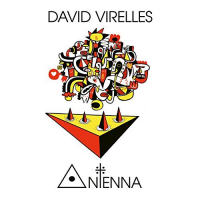 On Antenna—his second release for ECM—pianist/composer David Virelles takes his affinity for jazz and Cuban influences to another level, layering on sophisticated planes of improvisation along with ethnic rhythms. With an assortment of electronics, Hammond B-3, Roland Juno-6, electric and prepared pianos, the artist immerses himself in the kind of electronic mélange that has been his forte since his leader debut Mbókò (ECM, 2014).
On Antenna—his second release for ECM—pianist/composer David Virelles takes his affinity for jazz and Cuban influences to another level, layering on sophisticated planes of improvisation along with ethnic rhythms. With an assortment of electronics, Hammond B-3, Roland Juno-6, electric and prepared pianos, the artist immerses himself in the kind of electronic mélange that has been his forte since his leader debut Mbókò (ECM, 2014). Reunited with vocalist Román Díaz and drummer Marcus Gilmore from Mbókò, the album opens with "Binary," a piece consisting of programmed Afro-Cuban rhythms and sampled bird refrains. The bluesy contribution of Henry Threadgill's alto saxophone punctuates the otherwise drone and tone-oriented "Water, Bird-Headed Mistress." Cuban rapper Etián Brebaje furnishes the lines in a pop/funk "Rumbakua" while the pulsing arrangement of "El Titan de Bronce" permeates a serpentine maze of piano, guitar and drums.
Antenna seems an evolutionary step for Virelles; more experimental in nature than Mbókò and his first leader date Continuum (Pi Recordings, 2012), it nevertheless incorporates elements of both in a somewhat eclectically perplexing set. No one would suggest that an artist of broad-reaching ambitions and talents find a comfortable niche, but Virelles may benefit from a more focused approach. Track Listing: Binary; Water, Bird Headed Mistress; Threshold; Rumbakuá; El Titán de Bronce; Text. Personnel: David Virelles: acoustic piano, Hammond B3 organ, Roland JUNO-6, Vermona and Wurlitzer electric pianos, prepared piano, programming, samples; Alexander Overington: electronics, samples, cello; Henry Threadgill: alto saxophone (2); Román Díaz: vocals (3); Marcus Gilmore: drums (3,5), MPC (4); Rafiq Bhatia: guitar (3,5); Etián Brebaje Man: vocals (4); Mauricio Herrera: percussion (4); Los Seres: percussion (a fictional percussion ensemble, created and programmed by David Virelles) (1,6)
Photo credit: North Central College
< Previous
Playgrounds
Comments
Tags
Under the Radar
Karl Ackermann
Louis Armstrong
duke ellington
Thelonius Monk
Toronto
John Abercrombie
Vic Juris
Ingrid Jensen
Jon Faddis
Lionel Hampton
Charles Mingus
Dizzy Gillespie
Gary Smulyan
Woody Herman
Toshiko Akiyoshi
lew tabackin
Freddie Hubbard
Tito Puente
Clark Terry
Ralph Lalama
Thad Jones
Mel Lewis
John Mosca
Sarah Vaughan
Stan Getz
Kenny Washington
Lee Konitz
Betty Carter
Tommy Flanagan
Richie Morales
Spyro Gyra
Brecker Brothers
Gato Barbieri
Al Di Meola
Todd Coolman
Tim Cobb
Tony Bennett
Doug Munro
Pete Malinverni
Jody Sandhaus
eddie gomez
Dr. Lonnie Smith
David Newman
randy brecker
Michael Brecker
Cornell Dupree
David Sanborn
Toots Thielemans
Allen Toussaint
Sonny Rollins
pat metheny
Spike Wilner
Chick Corea
Horace Silver
Dave Holland
Vince Mendoza
joe lovano
John Scofield
Jack DeJohnette
Steve Gadd
Marcus Gilmore
Henry Threadgill
For the Love of Jazz
 All About Jazz has been a pillar of jazz since 1995, championing it as an art form and, more importantly, supporting the musicians who create it. Our enduring commitment has made "AAJ" one of the most culturally important websites of its kind, read by hundreds of thousands of fans, musicians and industry figures every month.
All About Jazz has been a pillar of jazz since 1995, championing it as an art form and, more importantly, supporting the musicians who create it. Our enduring commitment has made "AAJ" one of the most culturally important websites of its kind, read by hundreds of thousands of fans, musicians and industry figures every month.





